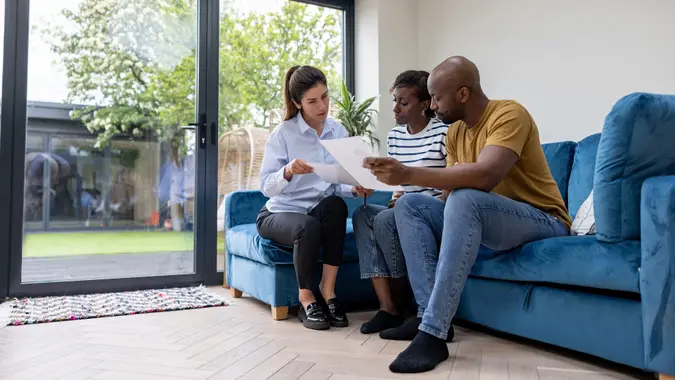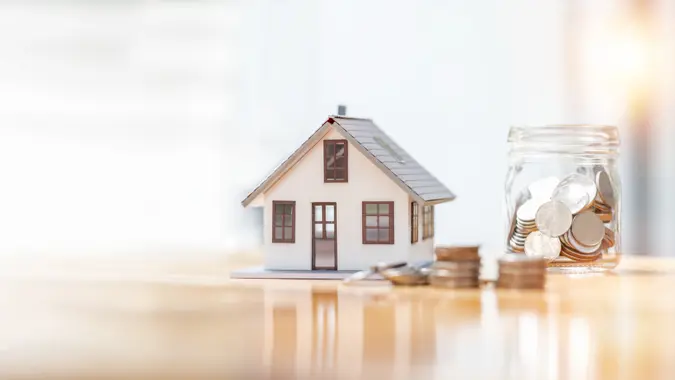How To Apply For a Mortgage: 11 Steps to Homeownership

Commitment to Our Readers
GOBankingRates' editorial team is committed to bringing you unbiased reviews and information. We use data-driven methodologies to evaluate financial products and services - our reviews and ratings are not influenced by advertisers. You can read more about our editorial guidelines and our products and services review methodology.

20 Years
Helping You Live Richer

Reviewed
by Experts

Trusted by
Millions of Readers
To make your dreams of homeownership come true, you’ll have to jump through a series of hoops known as the mortgage process. But it’s not as simple as filling out an application and waiting to see if you are approved. Instead, before you fill out a mortgage application, there are many steps to complete. And after you’ve successfully applied for your loan, there are additional steps that you must complete to take ownership of your new home.
Here’s a breakdown of the mortgage process that (hopefully) uncomplicates it a bit.
Step 1: Check Your Credit Report and Score
It’s important to know what’s on your credit report and your credit score before you apply for a mortgage loan. If your score is lower than you expected, your credit report might have errors that need to be corrected before you apply for the loan.
To get a conventional mortgage loan, you should have a credit score of at least 620. FHA loans require a credit score of at least 580. However, the higher your credit score, the better interest rate you will be able to qualify for, which means you will save money.
You can get free copies of your credit report from all three credit bureaus by visiting Annual Credit Report.com. Any errors you find in the report need to be corrected by filing a dispute with one or more of the three credit bureaus: Equifax, Experian and TransUnion.
Your credit report won’t contain your score. However, credit card companies often will provide your score to you for free, or you can check out a site like Credit Karma.
Step 2: Secure Your Down Payment
It’s important to secure your down payment before applying. You might have heard that you’ll need to put down 20% of the home’s purchase price to secure a mortgage loan. Although that would be ideal because it would decrease the amount of your loan, it’s not always necessary. You might be able to put down as little as 3% if your lender determines you can afford the monthly mortgage payments.
Step 3: Research Different Lenders
The next step is to research different mortgage lenders. Start with your bank or credit union; it might offer special rates and discounted fees to current customers. You can also shop online. All in all, you’ll want to compare interest rates and fees from at least three lenders.
Step 4: Gather the Documents You’ll Need To Apply
Applying for a mortgage requires submitting a variety of documents to the lender that contain your financial information. Here’s what you need to have available.
Paycheck Stubs
One of the first items the bank will want to see are your paycheck stubs from at least the last 30 days. Stubs support your claim that you’re currently employed and show your take-home pay, which is helpful in determining how much house you can afford.
Bank Statements
Around the same time, you’ll need to provide the most recent bank statement from each account that you hold. Bank statements allow the lender to see how much money you have on hand.
List of Assets
In case you have other assets aside from your bank accounts, you’ll need to give your lender a list when you provide other income information. Additional assets show you’re more financially prepared to take on the debt of homeownership.
List of Debts
Although your credit report will provide much of the information about your debts, the mortgage lender might need to verify certain debts or ask about additional debts to be able to accurately calculate your debt-to-income ratio.
W-2 Forms
Although you only need a month’s worth of pay stubs, the loan officer will also want to see your W-2 forms from the past two years. W-2 forms support both employment and income history.
Past Tax Returns
Many mortgage lenders request not one tax return, but two — especially if you are self-employed and don’t have any W-2s to prove your income. You can fill out Form 4506-T or Form 4506T-EZ to request transcripts of the tax returns if you didn’t save copies.
Year-to-Date Profit and Loss Statement
Another requirement banks often request of self-employed applicants is a completed year-to-date profit and loss statement. A P&L lets the lender know where your business stands financially.
Proof of Supplemental Income
In case you receive any supplemental income, such as SSI, commissions, overtime pay or tips or bonuses you’ll need proof. Additional income can help you qualify for a larger mortgage.
Proof of Rental Income
Should you own additional properties that you rent out, you can use this income toward qualifying for a mortgage. The bank might request that you submit Schedule E from your taxes, or they might simply ask for a copy of the current lease.
Gift Letter
When a friend or family member gifts you money toward your down payment, the bank requires a gift letter from the person who gave you the money. The purpose is to prove that the funds are a gift — not a loan.
Canceled Rent or Mortgage Checks
Request a copy of your canceled rent or mortgage checks to prove you’ve paid your landlord or current mortgage holder on time. Depending on the bank, you might also be asked to submit a residence history for the last two years.
Divorce Decree
The lender will want to see a copy of your divorce decree if applicable. A divorce decree will usually spell out child support or alimony requirements, which can make a difference in your income or expenditures.
Bankruptcy or Foreclosure Documents
Previous bankruptcies or foreclosures that have taken place in the last seven years must also be disclosed during the application process. It’s crucial for the lender to verify that you’re no longer obligated to satisfy any debts connected to previous bankruptcies or foreclosures.
Step 5: Get a Preapproval Letter From Your Lender
If you’re planning to purchase your new home within the next three months, you should get a preapproval letter from any lenders you’re potentially interested in applying for a mortgage loan with. A preapproval letter shows realtors and home sellers that you are serious about purchasing a home and that you have the means to do so, which can give you an advantage over other prospective buyers who don’t have a preapproval.
If your timeline for purchase is longer than three months, you’ll want to hold off on this step because preapprovals typically only last three months and they require lenders to do a hard inquiry, which will affect your credit score.
Step 7: Fill Out Mortgage Applications
After you find a house and make an offer, it’s time to fill out a mortgage application. You can fill out a mortgage application with any lenders you are interested in to be able to compare loan estimates.
Many financial experts suggest comparing offers from three different lenders so you can get the best deal. According to the Consumer Financial Protection Bureau, you don’t have to fill out the entire mortgage application at this point. Instead, you can get loan estimates by supplying each lender with the following pieces of information: name, income, Social Security number, address and sale price of home you want to purchase and the loan amount you’re requesting.
Step 8: Review Loan Estimates and Choose a Lender
Next, take the time to review the loan estimates you receive. Each loan estimate will detail the loan terms, projected payments and closing costs. If you need help, use this Loan Estimate Explainer from the Consumer Financial Protection Bureau. After reviewing the estimates, choose a lender based on the best loan offer.
Step 9: Be Available by Phone or Email
Once you choose a lender, your loan will start processing. Be available by phone or email to answer any questions or provide additional documentation. Typically, a mortgage takes 30 to 45 days to close, but it could be longer depending on the type of loan involved and the state of the housing market at the time.
Step 10: Compare the Closing Disclosure and Loan Estimate
At least three business days before you are scheduled to close on your loan, your lender is required to send you a Closing Disclosure, which details the actual costs of your mortgage loan. Compare the Loan Estimate you received from the lender with the Closing Disclosure to make sure the numbers match. It’s possible that some of the figures might have changed. If this is the case, ask your lender to clarify the changes.
For example, if your interest rate was not locked, it could have changed between the time you received the Loan Estimate and the Closing Disclosure. Also, check the “Cash to Close” section of the Closing Disclosure to see if you need to bring any money to the loan closing. If you need help, consult this Closing Disclosure Explainer from the CFPB.
Step 11: Attend the Mortgage Loan Closing
Congratulations — you’ve made it to closing day! The last step is to sign the necessary documents to finalize the loan and take ownership of your new home. This is also when you’ll pay any final costs.
More From GOBankingRates
- 6 Expensive Costco Items That Are Definitely Worth the Cost
- How Much Does the Average Middle-Class Person Have in Savings?
- 5 Reasons You Should Consider an Annuity For Your Retirement Savings
- 10 New Cars to Avoid Buying in 2024
Alicia Bodine contributed to the reporting for this article.
 Written by
Written by  Edited by
Edited by 

























